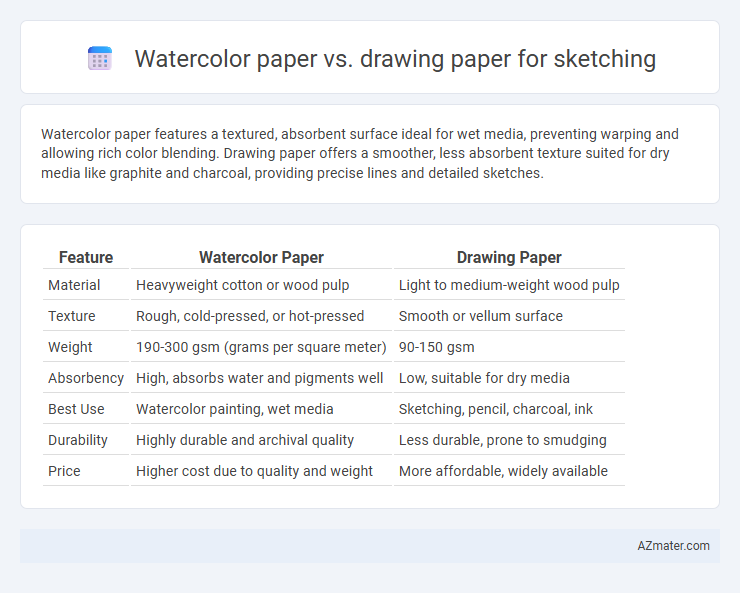Watercolor paper features a textured, absorbent surface ideal for wet media, preventing warping and allowing rich color blending. Drawing paper offers a smoother, less absorbent texture suited for dry media like graphite and charcoal, providing precise lines and detailed sketches.
Table of Comparison
| Feature | Watercolor Paper | Drawing Paper |
|---|---|---|
| Material | Heavyweight cotton or wood pulp | Light to medium-weight wood pulp |
| Texture | Rough, cold-pressed, or hot-pressed | Smooth or vellum surface |
| Weight | 190-300 gsm (grams per square meter) | 90-150 gsm |
| Absorbency | High, absorbs water and pigments well | Low, suitable for dry media |
| Best Use | Watercolor painting, wet media | Sketching, pencil, charcoal, ink |
| Durability | Highly durable and archival quality | Less durable, prone to smudging |
| Price | Higher cost due to quality and weight | More affordable, widely available |
Introduction to Paper Types for Sketching
Watercolor paper features a textured surface designed to hold and absorb water-based pigments, making it ideal for fluid, layered painting techniques. Drawing paper typically has a smoother finish suited for dry media such as graphite, charcoal, or colored pencils, offering crisp lines and fine detail. Choosing the right paper depends on the medium and effect desired in sketching, with watercolor paper supporting wet techniques and drawing paper enhancing dry sketching precision.
What is Watercolor Paper?
Watercolor paper is specifically designed to handle the moisture and absorption of water-based media, featuring a textured surface made from cotton or cellulose fibers. Its heavier weight and increased thickness prevent warping and enable vibrant pigment retention, making it ideal for watercolor techniques. Unlike drawing paper, which is smoother and thinner, watercolor paper supports multiple layers of washes and detailed brushwork without deteriorating.
What is Drawing Paper?
Drawing paper is a versatile, smooth-surfaced medium designed primarily for dry media such as graphite, charcoal, and colored pencils, providing controlled texture for fine detail and shading. It is lighter in weight compared to watercolor paper, typically ranging from 60 to 100 lb (90-150 gsm), which does not withstand heavy water application without warping or pilling. Its optimized surface absorbs dry media effectively but lacks the thickness and absorbency required to handle wet techniques characteristic of watercolor painting.
Texture Differences: Watercolor vs Drawing Paper
Watercolor paper features a rough, cold-pressed, or hot-pressed texture designed to absorb water and pigments effectively, preventing warping and allowing smooth color blending. Drawing paper, typically smoother with a fine or medium tooth, provides a consistent surface ideal for dry media like graphite, charcoal, and colored pencils. The pronounced texture of watercolor paper enhances wash techniques, while drawing paper's subtle grain supports detailed line work and shading precision.
Paper Weight and Thickness Comparison
Watercolor paper typically ranges from 140 lb (300 gsm) to 300 lb (640 gsm), providing substantial thickness and weight that prevents warping during wet media application. Drawing paper generally weighs between 60 lb (90 gsm) and 80 lb (130 gsm), offering a thinner, smoother surface ideal for dry media like pencils and charcoal. The increased thickness of watercolor paper supports heavy washes and layering, whereas the lighter drawing paper facilitates fine detail work but may buckle if exposed to moisture.
Absorbency and Media Handling
Watercolor paper features high absorbency due to its thicker, textured surface, allowing it to hold wet media like watercolors without warping or bleeding. Drawing paper, typically smoother and less porous, is designed for dry media such as graphite, charcoal, or colored pencils, offering better control for fine lines but limited absorption for wet applications. Choosing between the two depends on media handling needs: watercolor paper excels in managing liquids and blending, while drawing paper is ideal for precision and layering with dry materials.
Durability and Erasing Performance
Watercolor paper offers superior durability due to its thicker, textured surface that withstands multiple wet washes without warping, making it ideal for mixed media sketches. Drawing paper, while smoother and more suited for pencil and charcoal, lacks the same resistance to heavy erasing and repeated layering, often resulting in surface abrasion or tearing. Erasing performance favors drawing paper with its finer grain that allows clean removal of graphite, whereas watercolor paper's rough texture can trap graphite particles, reducing eraser effectiveness.
Ideal Uses: When to Choose Each Paper
Watercolor paper, with its thicker, textured surface and high absorbency, is ideal for wet media techniques such as washes, blending, and layering watercolors or inks, ensuring colors remain vibrant without warping. Drawing paper, smoother and lighter, suits dry media like pencils, charcoal, and pastels, providing a crisp surface for detailed lines and shading with less risk of smudging. Choose watercolor paper for mixed media and fluid techniques, while opting for drawing paper when precision and fine line work are paramount in your sketching projects.
Cost Considerations
Watercolor paper is typically more expensive than drawing paper due to its thicker weight, textured surface, and ability to withstand moisture without warping, making it suitable for wet media. Drawing paper is generally more affordable, designed for dry media, and offers a smoother finish ideal for pencils and charcoal, which can lower costs for sketching practice and everyday use. Choosing between the two depends on budget constraints and the desired artistic effect, with drawing paper providing economic value for dry sketches and watercolor paper offering durability for mixed-media applications.
Conclusion: Which Paper is Best for Sketching?
Watercolor paper is best suited for sketching when using wet media or mixed techniques due to its thick texture and high absorbency, preventing warping and allowing vibrant color blending. Drawing paper excels for dry media such as pencils, charcoal, or ink, offering a smooth surface that supports fine lines and detailed work. For sketching versatility, choosing the paper depends on the medium, with drawing paper ideal for dry sketches and watercolor paper preferable for fluid, expressive styles.

Infographic: Watercolor paper vs Drawing paper for Sketching
 azmater.com
azmater.com